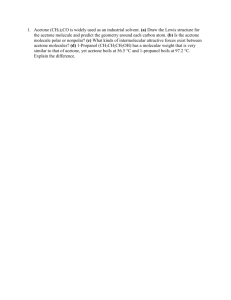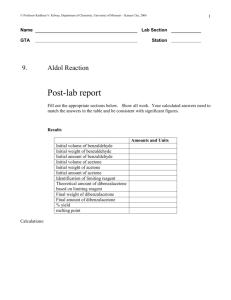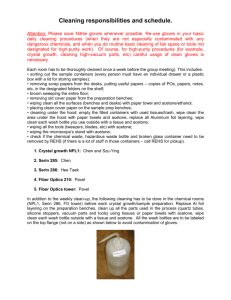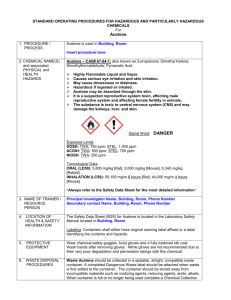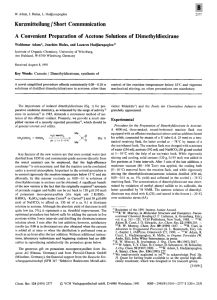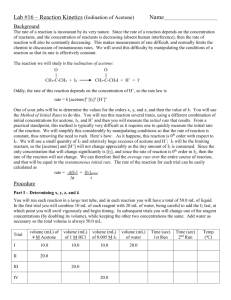Kinetics: Iodination of Acetone
advertisement
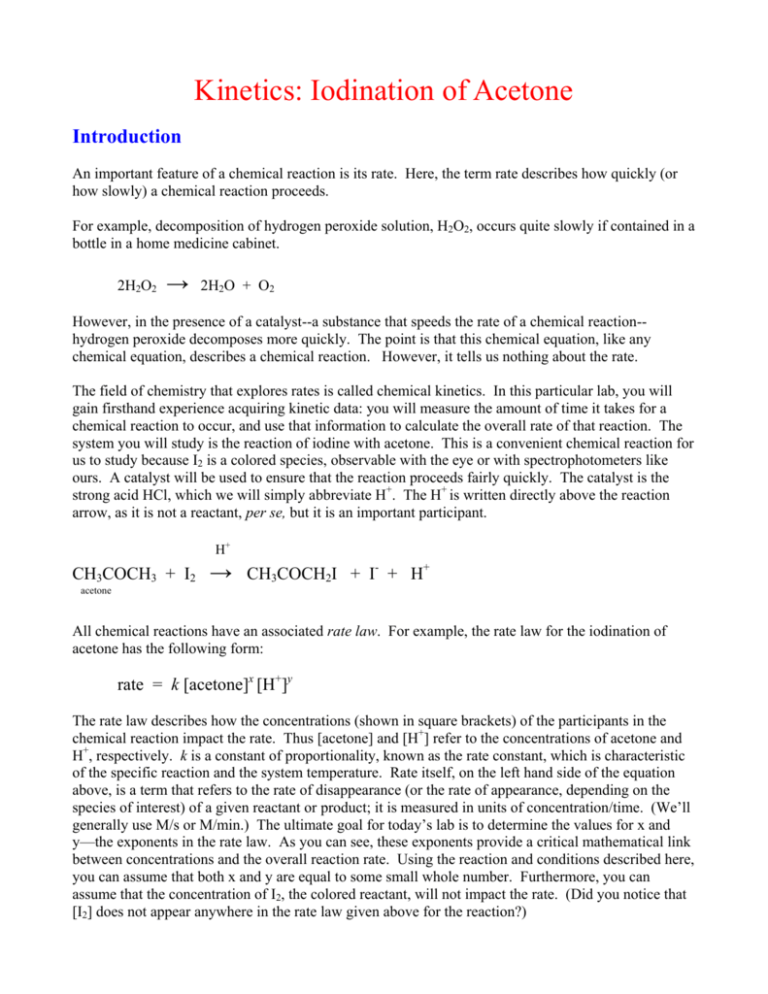
Kinetics: Iodination of Acetone Introduction An important feature of a chemical reaction is its rate. Here, the term rate describes how quickly (or how slowly) a chemical reaction proceeds. For example, decomposition of hydrogen peroxide solution, H2O2, occurs quite slowly if contained in a bottle in a home medicine cabinet. 2H2O2 → 2H2O + O2 However, in the presence of a catalyst--a substance that speeds the rate of a chemical reaction-hydrogen peroxide decomposes more quickly. The point is that this chemical equation, like any chemical equation, describes a chemical reaction. However, it tells us nothing about the rate. The field of chemistry that explores rates is called chemical kinetics. In this particular lab, you will gain firsthand experience acquiring kinetic data: you will measure the amount of time it takes for a chemical reaction to occur, and use that information to calculate the overall rate of that reaction. The system you will study is the reaction of iodine with acetone. This is a convenient chemical reaction for us to study because I2 is a colored species, observable with the eye or with spectrophotometers like ours. A catalyst will be used to ensure that the reaction proceeds fairly quickly. The catalyst is the strong acid HCl, which we will simply abbreviate H+. The H+ is written directly above the reaction arrow, as it is not a reactant, per se, but it is an important participant. H+ CH3COCH3 + I2 → CH3COCH2I + I- + H+ acetone All chemical reactions have an associated rate law. For example, the rate law for the iodination of acetone has the following form: rate = k [acetone]x [H+]y The rate law describes how the concentrations (shown in square brackets) of the participants in the chemical reaction impact the rate. Thus [acetone] and [H+] refer to the concentrations of acetone and H+, respectively. k is a constant of proportionality, known as the rate constant, which is characteristic of the specific reaction and the system temperature. Rate itself, on the left hand side of the equation above, is a term that refers to the rate of disappearance (or the rate of appearance, depending on the species of interest) of a given reactant or product; it is measured in units of concentration/time. (We’ll generally use M/s or M/min.) The ultimate goal for today’s lab is to determine the values for x and y—the exponents in the rate law. As you can see, these exponents provide a critical mathematical link between concentrations and the overall reaction rate. Using the reaction and conditions described here, you can assume that both x and y are equal to some small whole number. Furthermore, you can assume that the concentration of I2, the colored reactant, will not impact the rate. (Did you notice that [I2] does not appear anywhere in the rate law given above for the reaction?) Given these assumptions, it will be possible for you and your group members to conduct a series of simple experiments to determine not only x and y but also k, the rate constant for the iodination of acetone at the lab room temperature. How can we determine so many different values using just one experiment? The answer is that we will do a series of closely related experiments, taking advantage of the variety of concentrations of reaction participants available to you. Specifically, you will vary the concentration of acetone in some experiments, and you will vary the concentration of HCl (that is, [H+]), in others. In each of these individual trials, your goal will be to assess the rate at which I2 disappears. Since rate involves both concentration and time, the two pieces of “raw data” needed, at minimum, are the starting concentration of I2, along with the amount of time required for it to disappear. We’ll call the reaction starting time t0 and we’ll refer to the ending time (that is, when all of the I2 is gone and the solution has turned colorless) simply as t. Pre-lab Safety You must wear goggles, as you always do in the laboratory. Iodine is toxic and stains skin and clothing. Note: A small skin stain is not dangerous. Iodine solutions were once used to treat minor cuts. Acetone is highly flammable. There should be absolutely no open flames in the laboratory. Acetone and acetone solution bottles should be closed when not in use. HCl and other acids are hazardous if splashed on clothing, exposed skin or in the eyes. Prolonged exposure of the skin to even fairly dilute solutions of acid can cause burns. If acids and bases splash on skin or clothes, remove the affected clothing and flush the affected areas thoroughly with cold water. Prior to considering this week's prelab questions, please read this lab write-up in its entirety, and read sections 14.1 through 14.4 of your Burdge and Overby Chemistry: Atoms First textbook. 1. What is the chemical equation for the reaction we will study in this week’s experiment? 2. Define the word catalyst. What substance will be used as a catalyst in this week’s experiment? 3. Write the rate law for the general reaction given by aA + bB → cC + dD 4. Determine the rate of the chemical reaction shown directly below, given an NO concentration of 12.0 x 10-3 M, an H2 concentration of 3.0 x 10-3 M, and a rate constant k of 2.5 x 102 M-2s-1 The rate law for this reaction is rate = k [NO]2 [H2] 2NO + 2H2 → N2 + 2H2O Procedure Preparation of Solutions and Spectrometer 1. 2. Be sure to turn on the spectrometer and, after a brief warm-up, calibrate it. Prepare an acetone solution by placing 10.0 mL of pure acetone in a 50-mL size volumetric flask, and diluting to the mark with distilled water. What is the molar concentration of this solution? First “Timed Trial” The following is a suggested procedure for the very first timed trial(s) you perform for the iodination of acetone. (Once you are convinced that your group can execute this procedure reproducibly, you’ll be ready to use the guidelines entitled “Studying the Impact of Acetone and H+ Concentrations” to plan subsequent runs.) 1. Place 1.9 mL of distilled water in a cuvette 2. Add 0.8 mL of 1.0 M HCl 3. Add 0.8 mL of your group’s prepared acetone solution 4. Ready your stopwatch/clock to time your reaction 5. Add 0.5 mL of 0.005 M I2 solution 6. Begin timing the reaction immediately; place a cap on the cuvette and invert the cuvette several times to mix the contents 7. Place the cuvette in the calibrated spectrophotometer. Monitor the absorbance at 400 nm; record these readings at regular intervals until the absorbance reaches a nominal zero value (i.e., negligible absorbance). Studying the Impact of Acetone and H+ Concentrations As you plan for subsequent timed trials—that is, the ones in which the concentrations of acetone and acid are varied, with the aim of determining the exponents, x and y, in the rate law—there are several experimental constraints that must be borne in mind. First, our spectrometer, like any spectrometer, has a limited working range for absorbance measurements. As such, it is recommended that you not adjust the concentration of I2 from one trial to the next. Instead, add 0.5 mL of 0.005 M I2 for every trial. (This is not a practical inconvenience, since we have already stated that [I2] does not impact the rate of the chemical reaction under the conditions selected.) The second experimental limitation is that the reagent solutions are limited to your prepared acetone solution and the provided stock solutions. As such, your group will have to adjust the volume of a given reagent added to a cuvette if you wish to vary its concentration. This approach works well because each cuvette holds 4.0 mL of liquid; any increase or decrease in the quantity of acetone or HCl added should be accompanied by a corresponding change in the volume of added water, so that a net volume of 4.0 mL is employed for every trial. (This is also a practical concern; the spectrometer is not designed for use with partially filled cuvettes.) For example, if your group wanted to double the concentration of acetone relative to the starting recipe given above, the following combination of reagents would be recommended: 1.1 mL distilled water 1.6 mL acetone solution 0.8 mL 1.0 M HCl 0.5 mL 0.005 mL I2 solution Using this scheme, your group can systematically double, triple, or even halve the concentration of acetone or H+ for a given trial. Interpreting your Data The rate of disappearance of I2 is calculated from your experimental data using the equation rate = - [I2]/ t This equation can be further simplified to rate = [I2]i/t where t is simply the number of seconds elapsed from the start of the reaction (i.e., upon adding the I2), and [I2]i is the initial concentration of I2. (Note: the initial concentration of I2 is not 0.005 M!) Using the headers below, construct a table to summarize your concentration versus rate findings. Trial # [acetone] [H+] rate How do you use this table to learn more about the rate law? First, examine any pair of trials in which all concentrations are held constant. If your group performed any such trials, they are called replicates. If the calculated rate for each of these replicates is similar, their mere presence should bolster your confidence in your group’s technique and methods. Next, look at a pair of trials in which the concentration of acid was held constant while the concentration of acetone was varied. The variation in rate, if any, associated with a pair of trials in which [acetone] is systematically varied should exhibit a simple pattern. If the concentration of acetone does not have any impact on the reaction rate, it can be dropped from the rate law entirely; such a reactant is known as a zero-order reactant. If [acetone] does appear to impact the reaction rate, you should carefully examine how, on a quantitative level, the rate is impacted. If doubling the acetone concentration doubles the rate, halving the acetone concentration halves the rate, etc., then the reaction is said to be first-order with respect to acetone. In such a case, the exponent x for acetone in the rate law would simply be equal to 1, and you’ve just elucidated an important part of the rate law! If, on the other hand, doubling the concentration of acetone quadruples the reaction rate, you’ve just identified the mathematical phenomenon of a second-order reactant, and the exponent associated with [acetone] should be noted as 2. You can use this same approach to determine the simple whole-number exponent for H+. (As you study more about the broad subject of chemical kinetics, you’ll learn that some reactions exhibit rate laws with fractional, or even negative, exponents. Determining rate laws for these reactions requires calculations that go beyond the scope of this simpler, line-by-line examination of kinetics data.)

